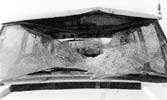|
Snatch ropes are useful as towing ropes and as tools in vehicle recovery. They can also be used
as tree protectors when winching. Their primary use is to duplicate an elastic-band effect to "snatch"
bogged vehicles out. Snatch ropes are available in a variety of shapes, sizes and weight ratings,
and most are nylon straps or ropes.
|
 |
 |
There are two main types of snatch ropes: one is a tow rope,
the other a "snatch" rope. Snatch ropes (also called recovery or kinetic straps) are often longer
and will therefore stretch more. The general rule of thumb is to pick a snatch rope with 3 to 4
times the weight rating of your vehicle's Gross Vehicle Weight (GVW). The table below provides an
indication of snatch rope types.
|
|
 |
| Length |
Width |
Weight Rating |
| 30 Foot |
2 Inch |
15,000 to 20,000 pounds |
| 30 Foot |
3 Inch |
20,000 pounds |
| 30 Foot |
4 Inch |
40,000 pounds |
| 35 Foot |
6 Inch |
60,000 pounds |
|
|
 |
| How Snatch Ropes Work |
 |
|
The combined weight of both vehicles, the vehicle motion and the elasticity
of the snatch rope combined can be used to multiply the potential energy,
which is converted to kinetic energy when the recovery process takes place.
When the recovery vehicle accelerates, the slack is taken up, the rope
stretches, and the energy produced snatches the bogged vehicle out, thus
multiplying substantially the amount of available energy that is used to
recover the bogged vehicle.
|
 |
| The Dangers of Snatch Recovery |
 |
|
The procedure begins with knowing and respecting the dangers of snatching.
As described above, kinetic energy is used to multiply the force used for
recovery. It also multiplies the danger if the snatch rope snaps or a towing
point tears loose. Imagine what a 3 pound hunk of metal, travelling at over
160km/h will do at the end of a rope if a tow hook was to come off your
chassis!
|
 |
 |
|
ALWAYS USE EXTREME CAUTION AND STAND CLEAR when using snatch
ropes. If the strap breaks, becomes disengaged or towing
fixtures tear loose, the strap will snap and whip wildly.
|
 |
|
NEVER ATTACH A SNATCH ROPE TO A VEHICLE'S TOW-HOOK OR
BUMBER. Tow hooks and bumpers are not designed to withstand
the stresses a snatch rope produces. Use the vehicle's
recovery points.
|
 |
|
Only use shackles to attach your snatch rope to a vehicle. DO NOT USE
PORTABLE HARDWARE such as hooks or chain to
attach snatch ropes to vehicles. NEVER JOIN TWO SNATCH ROPES TOGETHER
USING SHACKLES.
|
 |
|
PROTECT SNATCH ROPE FROM SHARP EDGES, ABRASIONS AND HEAT. Wash
in warm water after use. Replace immediately if cut, worn
or damaged.
|
 |
|
DO NOT USE THE SAME SNATCH ROPE MORE THAN 10 TIMES. Snatch ropes
loose their elasticity after each use and are weakened. Confirm
recommended maximum number of recoveries with your manufacturer.
|
 |
|
NEVER PERFORM SNATCH RECOVERIES WITH VEHICLES OF DISSIMILAR SIZE. The energy produced
during a snatch recovery can jerk the lighter vehicle into the
heavier vehicle, causing a collision.
|
|
 |
Complete tow hook and pintle recoiled through front and rear
windscreens of this Range Rover. Miraculously there were no
injuries. So long as the driver can see the controlling
marshaller (see below), raising the bonnet can be a useful ad
hoc safety shield during snatch recoveries.
This pic © Tom Sheppard's excellent book, Off-Roader
driving (ISBN 0-9532324-2-5, Desert Winds Publishing)
|
 |
|
 |
| The Snatch Recovery Procedure |
 |
|
Move the recovery vehicle in front or behind the stuck vehicle
(take a look first to see which is optimal). The distance between
the two must be about half the length of the snatch rope. Ideally,
a third person should be used to marshall the entire procedure.
|
 |
|
Attach the snatch rope securely to
recovery
points
on both vehicles, using shackles. Open the stuck vehicle's
bonnet, and lay a blanket or coat over the snatch rope to dampen the
whip should the snatch rope snap.
|
 |
 |
 |
|
Both drivers now get into and start their vehicles. Passengers are asked to
step out of the vehicle and join the bystanders. Bystanders are
warned of the dangers of vehicle recovery, and asked to stand well back.
The driver of the bogged vehicle will engage gear and assist the recovery
vehicle by attempting to drive in the direction being pulled.
|
 |
 |
 |
|
The recovery vehicle then GENTLY accelerates, until the jerk on the strap
is felt. Let the snatch rope bring you to a stop. The nylon webbing of the
snatch rope will stretch up to 20% and then recoil to its original length.
|
 |
 |
 |
|
When the snatch rope has recoiled, the bogged vehicle should have inched
forward a bit. You will be amazed at just how little momentum is required.
Remember to keep some tension on the strap to avoid abrasion from the road
surface. Gently repeat this process until the bogged vehicle is freed.
|
 |
|
 |
| Attachment Points |
 |
|
Recovery points should be
military specification on both vehicles. Where twin recovery or attachment
points are available, a bridle should be used, with safety lanyards, attached
respectively to the tow hitch and eye of the snatch rope. This evenly
distributes the strain onto the chassis, and halves the load on each recovery
point. The lanyard with restrain any metal from flying through the air should a
recovery point tear off the chassis.
|
|